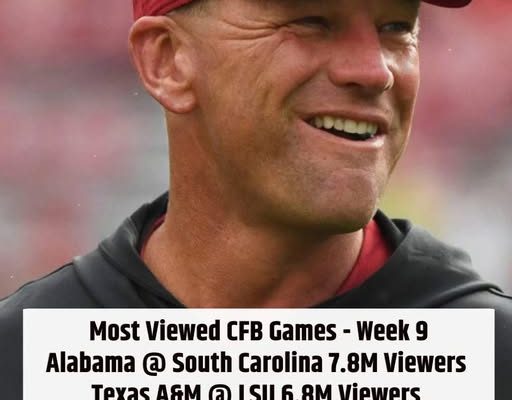The Alabama–South Carolina matchup dominated the airwaves, capturing the attention of millions across the country and reaffirming once again that Alabama football remains one of the biggest draws in American sports. In a weekend packed with marquee matchups and compelling storylines, it was the Crimson Tide’s clash with the Gamecocks that stood head and shoulders above the rest, becoming the most-watched college football game in the nation. With an audience of over 7.8 million viewers and a peak surge of 10.3 million during the most intense moments of the game, the broadcast didn’t just win the ratings war—it reminded everyone why Alabama football continues to be a cultural and television phenomenon.
From the opening kickoff to the final whistle, fans were glued to their screens. The drama, intensity, and history surrounding Alabama football have always carried a gravitational pull, and this matchup against South Carolina was no exception. Though the Gamecocks came in as underdogs, their spirited play and relentless energy created a spectacle that held fans captive from start to finish. For broadcasters, advertisers, and college football enthusiasts, the numbers told a clear story: when Alabama takes the field, America tunes in.
Part of what made this game such a television hit was the storyline leading up to it. Alabama entered the matchup with plenty to prove, coming off a string of dominant performances that reasserted their claim as one of college football’s elite programs. South Carolina, on the other hand, was looking to play spoiler—to challenge the mighty Crimson Tide and make a national statement of its own. That David-versus-Goliath energy is something viewers can’t resist. Add in the tradition, pageantry, and SEC passion that defined the matchup, and it’s no wonder millions couldn’t look away.
As the broadcast unfolded, it became clear that this wasn’t just another Saturday game—it was an event. Stadium lights reflected off a sea of crimson and garnet, and the crowd’s energy carried through television screens like a wave. Every big hit, every spectacular catch, every sideline reaction was magnified by the moment. Fans watching from home could feel the tension, the stakes, and the pride of two programs steeped in rich football heritage. When the numbers came in, networks and analysts weren’t surprised—they were impressed, but not shocked. Alabama football simply delivers.
The 7.8 million average viewership figure is impressive enough, but the real headline was the 10.3 million peak viewers that tuned in during the final quarter. That’s a staggering number for a regular-season college football game and a reflection of the national magnetism Alabama continues to hold. Few programs can consistently draw those kinds of audiences, regardless of opponent or setting. When Alabama plays, casual fans become invested, rivals tune in to see if the Tide will stumble, and loyal supporters rally around their team with unmatched intensity. It’s a perfect storm that makes for must-watch television.
From a broader perspective, Alabama’s continued dominance in TV ratings speaks to the brand power the program has built over the past two decades. Under Nick Saban, the Crimson Tide transformed from a proud regional powerhouse into a global football brand. The combination of success, consistency, and excellence has elevated the program to rarefied air, where every game feels like an event worth witnessing. That aura hasn’t faded—even with changes in staff, roster turnover, and the shifting landscape of college football. Alabama remains the standard, both on the field and on the airwaves.
The ripple effect of such massive viewership extends far beyond bragging rights. For television networks, a game like this translates to enormous advertising revenue and a valuable boost in prime-time ratings. For the SEC, it underscores the conference’s dominance not just in competition but in media influence. And for Alabama itself, it’s another testament to the program’s unmatched cultural relevance. When millions of people across the nation spend their Saturday focused on one team’s game, it becomes more than just football—it becomes a shared national experience.
The matchup also served as a reminder of how college football has evolved into a broadcast juggernaut. Gone are the days when only championship games drew nationwide audiences. Now, regular-season matchups can rival NFL games in viewership and energy. The Alabama–South Carolina showdown demonstrated this perfectly. It wasn’t a playoff or championship game, yet it felt like one. The stakes, the hype, and the delivery were all top-tier. Fans didn’t just watch—they invested emotionally. Social media lit up throughout the game, with hashtags trending and highlight clips circulating in real time. In an age where attention spans are shrinking, Alabama football still manages to command national focus for hours at a time.
For South Carolina, the game represented an opportunity to showcase its program on one of the biggest stages possible. While the result on the field may not have gone their way, the exposure was invaluable. Millions of potential recruits, alumni, and neutral fans saw a team that fought hard, executed with pride, and stood toe-to-toe with one of the sport’s titans. In many ways, that visibility can be as important as the scoreboard. A game like this shines a spotlight on both teams, creating ripples that affect recruiting, fundraising, and national perception for years to come.
Beyond the numbers, there’s something almost poetic about Alabama’s enduring appeal. The Crimson Tide have transcended the boundaries of fandom. They’ve become a measuring stick for greatness and a fixture in the American sports consciousness. Even viewers who don’t consider themselves Alabama fans find themselves watching, drawn by the allure of excellence. Whether it’s curiosity, admiration, or the hope of witnessing an upset, people tune in. Alabama has mastered the art of relevance, turning every game into an event that feels larger than life.
Media analysts often point to several key factors behind Alabama’s consistent ratings success. First and foremost is the program’s winning tradition. Viewers are naturally drawn to teams that perform at the highest level. Second is the recognizable brand—the crimson uniforms, the iconic script “A,” and the unmistakable aura of championship pedigree. Third, and perhaps most importantly, is the emotional investment fans have developed over years of dominance. Love them or hate them, everyone has an opinion about Alabama, and that kind of polarizing presence drives viewership.
The Alabama–South Carolina game also highlighted the shifting landscape of sports consumption. With streaming platforms and on-demand viewing changing how people watch entertainment, live sports remain one of the few arenas that can bring millions together in real time. And within that shrinking space, Alabama football continues to thrive. The broadcast numbers prove that even in a digital world, the tradition and immediacy of college football still command enormous collective attention. When the Tide take the field, fans across generations, regions, and backgrounds come together—some cheering, some hoping for an upset—but all watching.
What makes Alabama particularly fascinating is how the program manages to sustain this level of national engagement year after year. Other dynasties rise and fall, yet Alabama endures. Even when they face adversity, the intrigue only deepens. Every close game, every comeback, every challenge becomes a story in itself. The Crimson Tide are not just a team—they’re an ongoing saga, and audiences tune in for every chapter.
As for the networks, this matchup will likely serve as another benchmark for success. Executives will analyze viewership trends, regional breakdowns, and engagement levels, but one thing is already clear: when scheduling high-profile broadcasts, Alabama remains the gold standard. Their presence guarantees eyes on screens and excitement in the air. For college football as a whole, that’s a major win. The sport thrives when its biggest brands deliver moments that capture national attention, and Alabama has made that an art form.
Even beyond the business of sports media, the human element of this story can’t be overlooked. Fans—both in Tuscaloosa and across the country—live for these moments. Watching Alabama under the bright lights, seeing generations of talent take the field, and experiencing the collective roar of millions of voices celebrating the game is what makes college football special. The Alabama–South Carolina matchup wasn’t just a contest between two teams—it was a reminder of why people fall in love with the sport in the first place.
As the season continues, the numbers from this game will serve as yet another testament to Alabama’s unparalleled magnetism. They don’t just win games—they win attention, respect, and cultural relevance. Week after week, they prove that no matter who they play, no matter where they play, people will watch. The crimson tide doesn’t just roll across the field—it rolls across the nation, dominating ratings and redefining what it means to be a true powerhouse.
In the end, the 7.8 million who tuned in and the 10.3 million who watched the peak moments weren’t just watching football—they were witnessing a phenomenon. Alabama football once again proved that it’s more than a team; it’s a spectacle, a tradition, and a shared national heartbeat. In a world of fleeting trends and shifting loyalties, one thing remains constant: when Alabama takes the field, America stops to watch.



